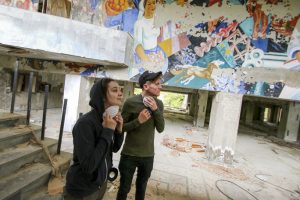Director Clara Casian applied to our Feature Expanded programme to help make the often-tricky transition from Visual Artist to filmmaker. Through the scheme, Casian met musician Robin Richards who invited her to collaborate on a live-scored film project set in Chernobyl ghost-town, Pripyat.
With the finished film Birdsong: Stories From Pripyat due to debut as part of our Artist Film Weekender, we spoke to Casian about the project and how Feature Expanded helped pave the way to a career in film…

CC: I come from Romania, I did my BA there and then I came over through Erasmus, the exchange program. Whilst there I was experimenting with animation and filmmaking and was interested in the relationship between still and moving image and how, when extracted out of their context, they become something else. Then I completed my Masters at the same university in Manchester and started developing work with focus on film and performance.
From your own experience how difficult is it to make the transition from Visual Artist to filmmaker and do you think the Feature Expanded programme helped that process?
CC: There were discussions about visual art and film and what the common ground was but it was not necessarily about making us work in a different way, it was more about understanding how we work and provide a space where these could negotiate in an interesting way. This relied on artists’ understanding of the film platform and the strategies used in commercial settings and seeing whether there’s a middle ground in between.
What was the most useful thing you took away from the Feature Expanded programme?
CC: My project is quite vast and niche so it was really interesting for me to see whether it would be possible to shape it into a feature length form. I work in an organic way so I was interested to see if I can keep the organic quality of the work and make a handcrafted thing whilst using tools and strategies that help build a precise framework graspable to an outsider audience or to people from outside the arts industry,
Has your career has benefited from being part of Feature Expanded?
CC: Oh yes, definitely. I’m still in conversation with the tutors from the programme and now I’m expanding the film – even though it’s not feature length, it’s 40 minutes – the feedback continues. I also keep in touch with the artists from the group. Some of them are based in London and their practices are quite similar to mine, so of course there are lots of benefits.
Speaking of Robin Richards, how did Birdsong: Stories From Pripyat come together?
CC: We met at a Feature Expanded networking event and he invited me to be part of the project. He thought my way of working with archival footage and narrative fitted the aims of the project.

CC: This is my first music and film collaboration and I really enjoyed feeding things back and forth with Robin and the overall process of building the visuals and the music. We have a studio together at Granada, I think having a space together it’s really important for the work.
What did you find when you went out to Chernobyl and saw it for yourself?
CC: The expectations are so high. You read stuff beforehand and you expect to be overwhelmed but at first I didn’t really felt anything because it takes time to feel immersed and get a sense of the space. There was this increasing paranoia about what you experience and of course there’s no touching and you have to follow the guide so I think that paranoia was inflicted by this increasing monitoring and surveying. Over the course of 2 days when I was in the zone, I had developed a sense of awareness of my own body and my presence in the space and I kept thinking about ways of visualising the internal and making something intangible tactile. So all of these things and reactions I’m hopefully trying to bring into the film.
What can audiences expect from the finished film and its live score?
CC: The narrative unravels over seven chapters. There’s this constant shift in between archival footage and new footage taken in Pripyat alongside testimonies that were collected whilst there. We also have text interviews with liquidators responsible for cleaning the contaminated land and they explained the politics behind it, procedures to do with the cleaning process and details on the aftermath of the disaster. The film is an observational piece that follows a narrative thread pieced together from people’s experiences. It’s a handcrafted film, it’s not a traditional documentary.
Do you have your next project lined up?
CC: I’m working on a 40 minute film about alternative publishing and censorship, which is now in the post-production phase.
Any finally, would you recommend Feature Expanded to other visual artists looking to expand their careers?
CC: Yes definitely. I think it’s highly beneficial if you have a clear project in mind as you would be able to better asses what directions and advice your project could take. It’s a great programme and lots of things have changed since I did it, so definitely.
Birdsong: Stories From Pripyat debuts on Friday 30 September as part of our Artist Film Weekender 2016. To find out more here.
HOME Digital in association with Virgin Media Business